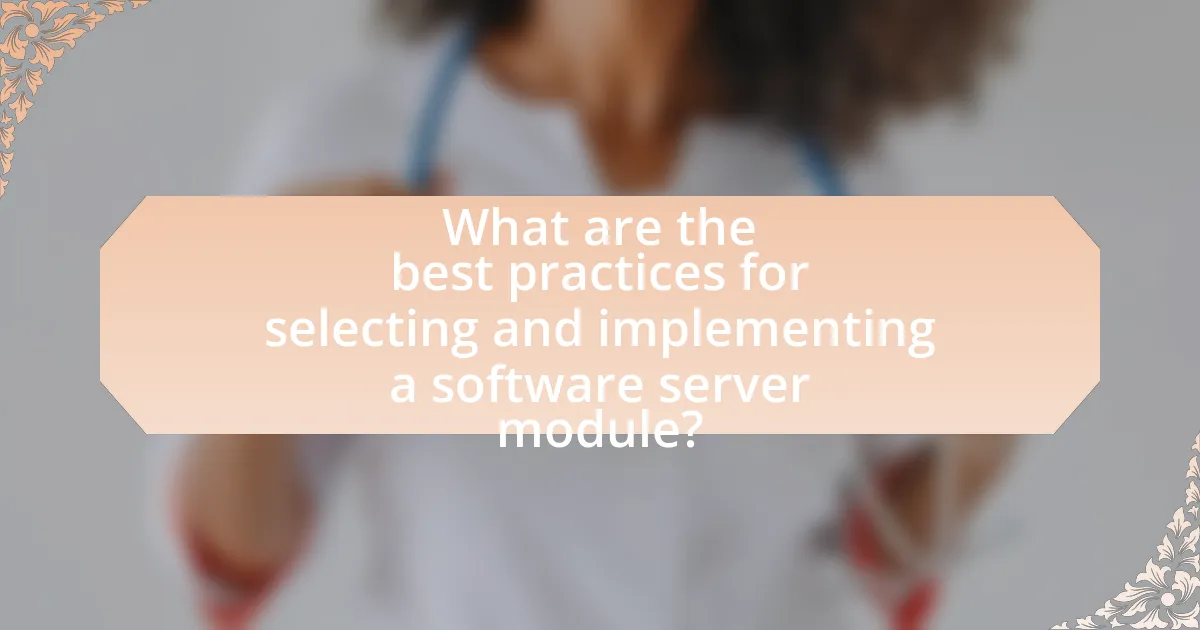The article focuses on selecting the appropriate software server module for infrastructure, emphasizing critical factors such as compatibility, scalability, performance, security, and vendor support. It outlines how the infrastructure’s purpose influences server module choice and details the specific applications supported by different types of server modules, including web, application, database, and file servers. Key technical specifications, such as processing power and memory capacity, are discussed, along with best practices for testing and implementing server modules to ensure reliability and efficiency. The article also highlights common pitfalls to avoid, such as overestimating needs and neglecting future scalability, to facilitate informed decision-making in server module selection.

What factors should you consider when choosing a software server module for your infrastructure?
When choosing a software server module for your infrastructure, consider factors such as compatibility, scalability, performance, security, and support. Compatibility ensures that the module integrates seamlessly with existing systems and applications, while scalability allows for future growth without significant reconfiguration. Performance metrics, including response time and resource utilization, are critical for maintaining efficiency. Security features, such as encryption and access controls, protect sensitive data and comply with regulations. Lastly, reliable support from the vendor can significantly impact the module’s effectiveness and longevity, as evidenced by studies showing that organizations with strong vendor support experience fewer operational disruptions.
How does the purpose of your infrastructure influence your choice of server module?
The purpose of your infrastructure directly influences your choice of server module by determining the specific requirements for performance, scalability, and functionality. For instance, if the infrastructure is designed for high-traffic web applications, a server module that supports load balancing and high availability is essential. Conversely, for a development environment, a lightweight server module may suffice. This alignment ensures that the server module can effectively handle the intended workload and meet user demands, as evidenced by studies showing that tailored server configurations can improve application performance by up to 30%.
What specific applications will the server module support?
The server module will support applications such as web hosting, database management, file storage, and application development. These applications are essential for various business operations, enabling users to host websites, manage data efficiently, store files securely, and develop software applications. The versatility of server modules allows them to cater to different operational needs, making them integral to modern IT infrastructure.
How does scalability impact your server module selection?
Scalability significantly influences server module selection by determining the ability of the server to handle increased loads without performance degradation. When selecting a server module, organizations must consider whether the module can efficiently scale up (adding resources to a single server) or scale out (adding more servers) to accommodate growth. For instance, cloud-based server modules often provide elastic scalability, allowing businesses to adjust resources dynamically based on demand, which is crucial for applications with variable workloads. This adaptability ensures that performance remains consistent during peak usage times, thereby enhancing user experience and operational efficiency.
What are the key technical specifications to evaluate in a server module?
The key technical specifications to evaluate in a server module include processor type, memory capacity, storage options, network connectivity, and power consumption. The processor type determines the performance capabilities, with options ranging from multi-core CPUs to specialized processors like GPUs. Memory capacity affects the server’s ability to handle multiple tasks simultaneously, with higher capacities allowing for better performance in demanding applications. Storage options, including SSDs and HDDs, influence data access speeds and overall system responsiveness. Network connectivity specifications, such as bandwidth and interface types, are crucial for ensuring efficient data transfer. Lastly, power consumption is important for operational cost management and environmental considerations, with energy-efficient designs contributing to lower long-term expenses.
What role does processing power play in server module performance?
Processing power is critical to server module performance as it directly influences the speed and efficiency of data processing tasks. Higher processing power enables a server module to handle more simultaneous requests, execute complex computations faster, and improve overall responsiveness. For instance, servers equipped with multi-core processors can manage multiple threads concurrently, significantly enhancing throughput and reducing latency. This is supported by benchmarks showing that servers with advanced processing capabilities can outperform those with lower specifications by up to 50% in transaction processing tasks, demonstrating the tangible impact of processing power on performance metrics.
How important is memory capacity in selecting a server module?
Memory capacity is crucial in selecting a server module as it directly impacts performance, scalability, and the ability to handle workloads. A server with insufficient memory may experience bottlenecks, leading to slower processing times and reduced efficiency. For instance, applications that require large datasets or run multiple virtual machines demand higher memory capacity to function optimally. Research indicates that servers with higher memory capacity can improve application performance by up to 50%, demonstrating the importance of memory in server selection.
What are the different types of software server modules available?
The different types of software server modules available include web server modules, application server modules, database server modules, and file server modules. Web server modules, such as Apache and Nginx, handle HTTP requests and serve web content. Application server modules, like JBoss and WebLogic, provide business logic and application services. Database server modules, including MySQL and PostgreSQL, manage data storage and retrieval. File server modules, such as Samba and FTP servers, facilitate file sharing and storage across networks. Each type serves a specific function within an infrastructure, ensuring efficient operation and resource management.
What distinguishes a web server module from an application server module?
A web server module primarily handles HTTP requests and serves static content, while an application server module processes dynamic content and business logic. Web server modules, such as Apache HTTP Server, focus on delivering files like HTML, CSS, and images directly to clients, utilizing protocols like HTTP. In contrast, application server modules, such as JBoss or WebLogic, provide an environment for executing server-side applications, managing resources, and facilitating communication between clients and databases. This distinction is evident in their functionalities: web servers optimize for speed and efficiency in serving static files, whereas application servers are designed to support complex application logic and transactions.
How do database server modules differ from other types?
Database server modules differ from other types by specifically managing data storage, retrieval, and manipulation, whereas other server modules may focus on different functionalities such as application hosting or web serving. Database server modules are designed to handle structured data and utilize query languages like SQL for data operations, ensuring data integrity and security. In contrast, application servers may execute business logic and serve dynamic content, while web servers primarily deliver static content over HTTP. This distinction is crucial as database servers optimize data transactions and support concurrent access, which is essential for applications requiring real-time data processing.

How can you assess the compatibility of a software server module with your existing infrastructure?
To assess the compatibility of a software server module with your existing infrastructure, conduct a thorough evaluation of system requirements, dependencies, and integration capabilities. Begin by comparing the software module’s technical specifications, such as operating system compatibility, hardware requirements, and network protocols, against your current infrastructure setup. Additionally, analyze any dependencies the module may have on other software or services, ensuring they align with your existing systems.
For instance, if the software module requires a specific version of a database or middleware, verify that your infrastructure supports it. Furthermore, consider the integration capabilities, such as APIs or data formats, to ensure seamless communication between the new module and your existing applications. This methodical approach ensures that the software server module can function effectively within your current environment, minimizing potential disruptions and maximizing performance.
What factors determine compatibility with current hardware?
Compatibility with current hardware is determined by several key factors, including hardware specifications, software requirements, and system architecture. Hardware specifications, such as CPU type, RAM capacity, and storage interfaces, must align with the software’s minimum requirements to ensure proper functionality. Software requirements detail the necessary operating system versions and dependencies that must be met for the software to operate effectively. Additionally, system architecture, whether 32-bit or 64-bit, influences compatibility, as software must match the architecture of the hardware to run correctly. These factors collectively ensure that the software can leverage the hardware’s capabilities without conflicts or performance issues.
How do operating systems affect server module compatibility?
Operating systems significantly influence server module compatibility by determining which software can run effectively on the hardware. Each operating system has specific kernel architectures, system calls, and libraries that server modules must align with to function correctly. For instance, a server module designed for Linux may not operate on Windows due to differences in file systems, process management, and network protocols. Compatibility issues can arise if the server module relies on features or APIs that are not supported by the operating system, leading to potential failures or suboptimal performance. Therefore, selecting a server module that is explicitly designed for the intended operating system is crucial for ensuring seamless integration and functionality.
What network requirements should be considered for compatibility?
Network requirements for compatibility include bandwidth, latency, protocol support, and security standards. Bandwidth must meet the demands of the applications being used, as insufficient bandwidth can lead to performance issues. Latency should be minimized to ensure timely data transmission, particularly for real-time applications. Protocol support is essential, as different software server modules may rely on specific communication protocols; compatibility with widely used protocols like TCP/IP is crucial. Lastly, adherence to security standards, such as encryption and authentication protocols, is necessary to protect data integrity and confidentiality. These factors collectively ensure that the software server module operates effectively within the existing network infrastructure.
How can you evaluate the integration capabilities of a server module?
To evaluate the integration capabilities of a server module, assess its compatibility with existing systems and protocols. This involves examining the module’s support for standard APIs, data formats, and communication protocols such as REST, SOAP, or GraphQL. Additionally, review documentation and user feedback to determine ease of integration and any reported challenges. For instance, a server module that supports widely-used standards and has positive integration case studies demonstrates strong integration capabilities, as evidenced by successful deployments in similar environments.
What APIs or protocols should you look for in a server module?
When selecting a server module, look for APIs and protocols such as REST, SOAP, GraphQL, WebSocket, and gRPC. These APIs and protocols facilitate communication between the server and clients, ensuring efficient data exchange and interoperability. REST is widely used for its simplicity and statelessness, while SOAP provides a protocol for exchanging structured information. GraphQL allows clients to request specific data, optimizing bandwidth usage. WebSocket enables real-time communication, and gRPC offers high-performance RPC capabilities. The choice of these APIs and protocols is validated by their widespread adoption in modern web services and applications, ensuring compatibility and scalability in various infrastructure setups.
How does vendor support influence integration success?
Vendor support significantly influences integration success by providing essential resources, expertise, and timely assistance during the integration process. Effective vendor support ensures that organizations can address technical challenges quickly, which minimizes downtime and accelerates the overall integration timeline. For instance, a study by the IT Services Management Forum found that organizations with strong vendor support reported a 30% higher success rate in integration projects compared to those with limited support. This correlation highlights the critical role that vendor engagement plays in facilitating smooth transitions and resolving issues that may arise during integration.

What are the best practices for selecting and implementing a software server module?
The best practices for selecting and implementing a software server module include defining clear requirements, evaluating compatibility, assessing performance, ensuring security, and planning for scalability. First, organizations should identify specific needs such as functionality, user load, and integration capabilities to guide the selection process. Next, compatibility with existing infrastructure and software is crucial to avoid integration issues, as highlighted by studies showing that 70% of software failures stem from compatibility problems. Performance assessments should include load testing to ensure the module can handle expected traffic, with benchmarks indicating that performance can impact user satisfaction by up to 50%. Security considerations must involve evaluating the module’s compliance with industry standards and its ability to protect against vulnerabilities, as data breaches can cost organizations an average of $3.86 million. Finally, planning for scalability ensures that the module can grow with the organization, which is essential given that 60% of businesses report that scalability is a key factor in software selection.
How can you effectively test a server module before full deployment?
To effectively test a server module before full deployment, implement a comprehensive testing strategy that includes unit testing, integration testing, performance testing, and user acceptance testing. Unit testing ensures that individual components function correctly, while integration testing verifies that these components work together seamlessly. Performance testing assesses the module’s responsiveness and stability under load, and user acceptance testing involves end-users to confirm that the module meets their requirements. According to a study by the National Institute of Standards and Technology, thorough testing can reduce software defects by up to 90%, highlighting the importance of a structured testing approach prior to deployment.
What types of testing should be conducted to ensure reliability?
To ensure reliability, various types of testing should be conducted, including unit testing, integration testing, system testing, and acceptance testing. Unit testing verifies individual components for correctness, while integration testing assesses the interaction between those components. System testing evaluates the complete system’s compliance with specified requirements, and acceptance testing ensures the system meets business needs and user expectations. These testing types collectively contribute to identifying defects early, improving software quality, and ensuring that the software performs reliably under expected conditions.
How can pilot programs help in the selection process?
Pilot programs can significantly enhance the selection process by allowing organizations to test software server modules in a controlled environment before full-scale implementation. This testing phase provides valuable insights into the module’s performance, compatibility, and user experience, enabling informed decision-making. For instance, a pilot program can reveal potential issues or limitations that may not be apparent during initial evaluations, thus reducing the risk of costly mistakes. Additionally, feedback from users during the pilot can guide adjustments and improvements, ensuring that the final selection aligns closely with organizational needs and operational requirements.
What common pitfalls should you avoid when choosing a server module?
When choosing a server module, avoid the pitfall of not assessing compatibility with existing infrastructure. Ensuring that the server module integrates seamlessly with current systems is crucial, as incompatibility can lead to operational disruptions and increased costs. Additionally, neglecting to evaluate scalability can hinder future growth; a server module should accommodate increasing workloads without requiring a complete overhaul. Another common mistake is overlooking security features; inadequate security can expose sensitive data to breaches. Lastly, failing to consider vendor support can result in challenges during implementation and maintenance, as reliable support is essential for troubleshooting and updates.
How can overestimating needs lead to poor module selection?
Overestimating needs can lead to poor module selection by causing organizations to choose overly complex or expensive modules that exceed their actual requirements. This misalignment often results in wasted resources, as the selected modules may include unnecessary features that complicate implementation and increase maintenance costs. For instance, a study by Gartner indicates that 70% of software projects fail due to misalignment between business needs and technology solutions, highlighting the importance of accurately assessing requirements to avoid selecting inappropriate modules.
What are the risks of ignoring future scalability in your choice?
Ignoring future scalability in your choice can lead to significant operational risks, including performance bottlenecks, increased costs, and potential system failures. When a software server module lacks scalability, it may struggle to handle increased loads, resulting in slow response times and degraded user experience. For instance, a study by Gartner indicates that 70% of organizations experience performance issues due to inadequate scalability, which can lead to lost revenue and customer dissatisfaction. Additionally, the inability to scale can necessitate costly migrations to new systems or architectures, further straining resources and disrupting business continuity. Therefore, neglecting scalability can compromise both immediate functionality and long-term growth potential.
What tips can help ensure a successful implementation of your chosen server module?
To ensure a successful implementation of your chosen server module, conduct thorough planning and testing before deployment. This involves defining clear objectives, assessing compatibility with existing infrastructure, and performing pilot tests to identify potential issues. Research indicates that organizations that engage in comprehensive pre-implementation assessments experience a 30% reduction in deployment-related problems, as highlighted in the “IT Project Success Rates” study by the Standish Group. Additionally, involving stakeholders throughout the process fosters collaboration and addresses concerns early, further enhancing the likelihood of a smooth implementation.